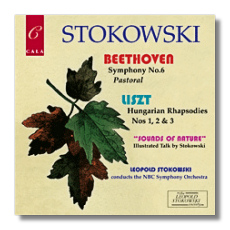
The Internet's Premier Classical Music Source
Related Links
-
Beethoven Reviews
Liszt Reviews - Latest Reviews
- More Reviews
-
By Composer
-
Collections
DVD & Blu-ray
Books
Concert Reviews
Articles/Interviews
Software
Audio
Search Amazon
Recommended Links
Site News
 CD Review
CD Review
Stokowski Conducts

- Ludwig van Beethoven: Symphony #6 "Pastoral"
- Franz Liszt:
- Hungarian Rhapsody #1 in F minor
- Hungarian Rhapsody #2 in C Sharp minor
- Hungarian Rhapsody #3 in D Major
- "Sounds of Nature" (Illustrated discussion by Stokowski)
NBC Symphony Orchestra/Leopold Stokowski
Cala CACD0545 74:28
My first reaction was to write the word "delightful"; later I penned "wonderful solos". The more I listen to the symphony (I played it on the stereo system in my car on the way to work and home today) the more I like this version. It swings and is involving. I plan to go back and listen to the '45 recording some more. I compared it with Stokowski's 1945 recording with the N.Y. City Symphony Orchestra and this is in every way superior. Of course recording advances, most notably tape, are one reason for this. It enables us to really appreciate the contributions of the fabulous soloists, who are fittingly credited in the notes. There is air around the music, strings are feathery and of course there is the Stokowski Sound, the rich bass line. It is a truly heavenly recording. Some time is spent in the notes discussing Stokowski's tempo for the second movement (Scene by the Brook). This is a bit of a snowman argument. The fact is that any given stream will flow slowly at points where it is deeper and this is what Stokowski achieves, a deeper feeling.
As for the "talk" all I can think of when I hear the brook is water running down a sink drain. I just sat through Stokowski's "talk" for the fourth time. How awfully dreadful. It is camp. I love camp.
Then we have the Liszt items. I first heard them on a Quintessence LP with "electronic stereo" effects and fell in love with them then. In his interview with Dan Rather Stokowski opines, "Emotion, life… or lifeless." The soloists in the third Hungarian Rhapsody were recorded at a separate session from the orchestra and then spliced into the orchestral fabric. You can't tell this at all and they make a fantastic contribution (Stokowski uses viola and cimbalom instead of the clarinet and cimbalom). This is truly "HUNGARIAN" and full of emotion.
In short, this is another fantastic disc from the Stokowski Society. Kudos all around.
Copyright © 2006, Robert Stumpf II





















